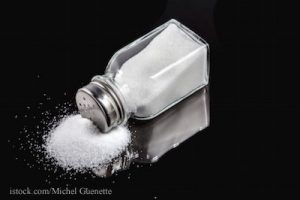Almost all adult Americans consume too much sodium, according to a report from the Centers for Disease Control and Prevention. Ninety percent of the sodium in our diets comes from food, and the sodium we get from foods is concentrated in prepared foods and processed foods; it’s not added at the table via the salt shaker.
Most of us know that consuming too much sodium can contribute to diseases such as high blood pressure (hypertension). But there are some diseases linked to high sodium intake that may be surprising.
- Diabetes
- Gallbladder disease
- Heart disease
- Stroke
- Osteoarthritis
- Endometrial cancer
- Breast cancer
- Colon cancer
- Kidney disease
- Obesity
Some scientists and doctors think that the ratio of sodium to potassium in your diet may be an even more important factor in your health. Sodium can stiffen your arteries and block nitric oxide, a compound that can relax your arteries. Potassium activates nitric oxide, relaxing the arteries, which can reduce blood pressure.
 Your body’s sodium requirement is actually quite low at about 220 milligrams per day. But the average American adult gets more than 3,300 milligrams a day. The current Dietary Guidelines recommends 2,300 milligrams a day, which is about a teaspoon. But if you have a high risk for developing diseases such as the ones in the above list, or are over age 51, you should limit sodium intake to 1,500 milligrams a day.
Your body’s sodium requirement is actually quite low at about 220 milligrams per day. But the average American adult gets more than 3,300 milligrams a day. The current Dietary Guidelines recommends 2,300 milligrams a day, which is about a teaspoon. But if you have a high risk for developing diseases such as the ones in the above list, or are over age 51, you should limit sodium intake to 1,500 milligrams a day.
Our sodium consumption has skyrocketed in the last 40 years. We now rely more on processed foods, fast food, and restaurant foods, which are usually packed with salt to add flavor. Producers and chefs are not required to limit salt because it’s on the FDA’s Generally Regarded As Safe (GRAS) list. By the same token, our potassium consumption has decreased, because that ion declines in foods such as tomatoes, bananas, and potatoes, when they are processed.
The study listed ten types of processed foods that contribute 44% of our sodium intake. Those foods are:
- Breads and rolls
- Cold cuts/cured meat such as deli ham or beef
- Pizza
- Fresh and processed poultry (injected with a brine solution)
- Soups
- Cheeseburgers and other sandwiches
- Cheese
- Pasta mixed dishes
- Meat dishes such as meat loaf with sauce
- Savory snack foods such as chips and pretzels
Most sodium consumed came from products purchased from a supermarket or convenience store; in other words, foods you prepare at home, from scratch, are not included in this group.
The study concludes by saying that if Americans reduce their sodium intake by 25%, we could prevent up to 28,000 deaths from any cause and save $7 billion in annual health care expenses.




